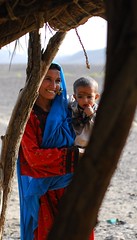by Mysbah Balagamwala
Norms can be defined “actions regarded by a set of persons as proper and correct, or improper and incorrect”[1]. By focusing on the language used by our respondents to describe their childcare and health practices and the changes that had taken places in these practices over the last few years, we were able to gain some valuable insights about the norms present in our fieldwork sites. Through our interviews we noticed differences in maternal and childcare norms between Badin and Shahdadpur which shed some light on the importance of understanding norms and how change takes place.
Prevention versus reaction
In both Badin and Shahdadpur, respondents told us that they take their children to the doctor or go themselves if they are unwell i.e. there was engagement with modern health services. However, the nature of engagement with these services was different. In Shahdadpur, the attitude towards health-seeking was preventive, in contrast to Badin where health-seeking was usually a response to a problem. For instance, in Shahdadpur, informants told us that most women were now opting to deliver their babies in hospital instead of the traditional practice of home-births. The common reason given for this change was khauf or the fear of something going wrong at home. I did not hear comparable words in Badin.
Fertility norms seemed to be changing in the villages of Shahdadpur as well, and were different to those in Badin. In my conversations with women in Shahdadpur what struck me the common reference to tubal-ligation (surgical sterilisation of women) as an option for restricting the number of children. The preferred choice was five or six children, which is a high number, but a smaller one according to my informants compared to previous generations. In contrast, women in Badin were not actively choosing to limit their family sizes and it was common for women to have seven, eight children or even more.
Awareness of ‘good’ practices
Child-feeding norms were also different in the two areas. Exclusive breastfeeding for six months is a recommended feeding practice and we used this as a proxy to judge a woman’s awareness about good childcare practices. In Shahdadpur, our respondents reported that the prevalence of exclusive breastfeeding was high. Of course, it may be possible that in practice this was not so especially since many women leave their infants at home while they go out in the agricultural fields to work. However, just their claim to breastfeed exclusively for six months signalled their awareness about the recommended practice. In interviews in Badin, on the other hand, it repeatedly became apparent that mothers were not aware of the recommended practice. Here respondents said that they gave water to their children as early as one month and even semi-solid foods were being introduced to three month old infants.
Changing norms
Even though we did not statistically measure change or outcomes, by comparing the norms and practices in the two sites and by listening to our informants talk about changes in their communities, it became apparent that norms were transforming in Shahdadpur. In Badin, a similar change was not visible. Even within Shahdadpur, however, the change in norms was not uniform across social groups. Among the Khaskhelis – the dominant kinship group in the area – for example, the change in norms seemed to be more apparent. The norms among the socially-marginalised Bheels, however, were closer to those observed in Badin.
Various factors, such as disparities in education levels, overall income and prosperity of the area or the relative empowerment of women, might explain variances in norms in the two areas. What appears to play an important role, however, is the difference in outreach of health services and the development of health infrastructure in the two areas. For instance, in the villages we surveyed in Shahdadpur, there were active Lady Health Workers (LHWs) who provided counselling on family planning while in Badin many of our respondents were never visited by a LHW. Norms shift gradually and the consistent exposure of women to health services in Shahdadpur may explain why a change is seen.
Apart from availability of public services, an improvement in their quality is another possible driver of change. The local hospital in Shahdadpur, a government facility, had recently been upgraded. Better quality free healthcare services were an impetus for people to use modern health facilities over home-based methods. In the Badin villages, on the other hand, there was an absence of well-functioning government health facilities and people had no choice but to use fee-charging private health services. As a result, norms over here may not have changed as constraints in resources may prevent people from adopting better practices.
Our initial findings show that an understanding of norms is important while designing and evaluating health and social policies and programmes for outcomes such as nutrition. Norms can be sticky and may determine how easily ‘good’ or recommended practices are adopted. Norms, however, can transform as in the case of Shahdadpur where supply-side factors (improvements in modern health services) might have caused a shift in maternal and child care norms. The change can be slow at first– awareness of an issue may not lead to prompt changes in practice, and availability of a resource (e.g. hospitals) may not imply its immediate utilisation. However, once there are some improvements in the availability of well-functioning institutions providing good quality services, norms can start to change and a virtuous cycle can kick-in through which new norms can gradually replace old ones.
[1] Coleman, 1990 qtd in Keefer and Knack (2005), “Social Capital, Social Norms and the New Institutional Economics”

